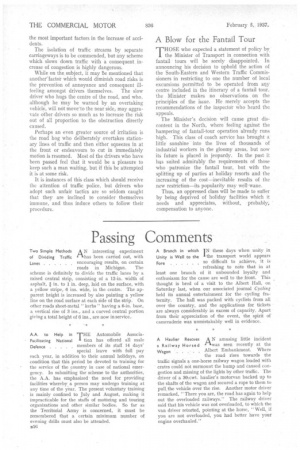Passing Comments Two Simple Methods A N interesting experiment of Dividing Traffic rm.has been carried out, with
Page 30

Page 31

If you've noticed an error in this article please click here to report it so we can fix it.
Lanes encouraging results, on certain roads in Michigan. The scheme is definitely to divide the traffic lanes by a raised central strip, consisting of a 12-in, width of asphalt, in. to 1 in. deep, laid on the surface, with a yellow stripe, 6 ins, wide, in the centre. The apparent height is increased by also painting a yellow line on the road surface at each side of the strip. On other roads sheet-metal " kerbs " having a 6-in, base, a vertical rise of 3 ins., and a curved central portion giving a total height of 6 ins., are now in service.
A.A. to Help in HE Automobile Associa Facil itating National tion has offered all male Defence members of its staff 14 days' special leave with full pay each year, in addition to their annual holidays, on condition that this period be devoted to training for the service of the country in case of national emergency. In submitting the scheme to the authorities, the A.A. has emphasized the need for providing facilities whereby. a person may undergo training at any time of the year. The present voluntary training is mainly confined to July and August, making it impracticable for the staffs of motoring and touring organizations and other similar bodies. So far as the Territorial Army is concerned, it -must be remembered that a certain minimum number of evening drills must also be attended. I N these days when unity in the transport world appears so difficult to achieve, it is refreshing to note that in at least one branch of it unbounded loyalty and enthusiasm for the cause are well to the front. This thought is bred of a visit to the Albert Hall, on Saturday last, when our associated journal Cycling held its annual entertainment for the cycling fraternity. The ball was packed with cyclists from all over the country, and the applications for tickets are always considerably in excess of capacity. Apart from their appreciation of the event, the spirit of cameraderie was unmistakably well in evidence. A Branch in which Unity is Well to the
Fore
AN amusing little incident rAwas seen recently at the Albert Embankment. Where the road rises towards the traffic signals a one-horse railway wagon loaded with crates could not surmount the hump and Caused congestion and missing of the lights by other traffic. The driver of a 30-cwt. haulier's motorvan backed up to the shafts of the wagon and secured a rope to them to pull,, the vehicle over the rise. Another motor driver remarked, "There you are, the road has again to help out the overloaded railways." The railway driver said that his vehicle was not overloaded, to which the van driver retorted, pointing at the horse, "Well, if you are not overloaded, you had better have your engine overhauled."
A Haulier Rescues a Railway Horsed Wagon
Are -L" Plates NecesgomE doubt seems to exist in sary on Heavy Goods "the industry as to the need Vehicles? for "L" plates for heavy goods
vehicles on which drivers are being taught. Actually, the fitting of such a plate is one of the conditions on which a provisional driver's licence is granted.
Electric dischargeT is now generally recogLighting System I nized that the problem of Makes Headway street accidents after dark is inseparably bound up with the question of lighting, and exhaustive experiments have proved conclusively that, if road illumination can be improved, the risk of accidents is greatly minimized. The General Electric Co., Ltd., has tackled the matter boldly, and its Osira electric-discharge lamp is undoubtedly a valuable contribution to road safety, as we have testified for ourselves on
numerous stretches of highway. Not only is the system which employs this lamp making headway in the British Isles, in which 560 miles are lit by 20,000 Osira lamps, but there are 111 miles of similarly illuminated roads, using 3,875 such lamps, installed overseas.
River Tunnel Traffic A SPECIAL electrical in Controls Its Own stallation has been carried Ventilation . . . out in the road traffic tunnel below the River Scheldt between Antwerp and Hoboken. This keeps a record of the number of vehicles passing through. the tunnel in both directions, and of the number in the tunnel at any one time. The latter figure controls the ventilation plant so that the degree of ventilation can be varied accordingly. This has been found necessary owing to the " fog " created by exhaust gases, and the dust raised when traffic through the funnel is crowded.




























































































